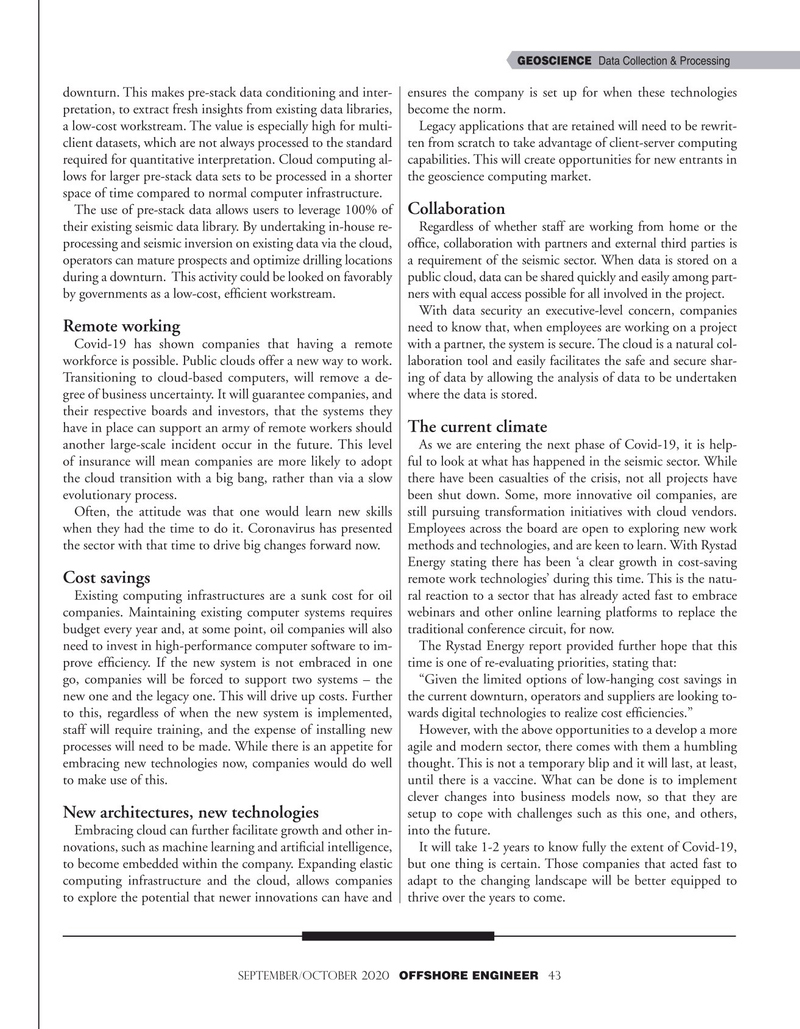
Page 43: of Offshore Engineer Magazine (Sep/Oct 2020)
Read this page in Pdf, Flash or Html5 edition of Sep/Oct 2020 Offshore Engineer Magazine
GEOSCIENCE Data Collection & Processing downturn. This makes pre-stack data conditioning and inter- ensures the company is set up for when these technologies pretation, to extract fresh insights from existing data libraries, become the norm. a low-cost workstream. The value is especially high for multi- Legacy applications that are retained will need to be rewrit- client datasets, which are not always processed to the standard ten from scratch to take advantage of client-server computing required for quantitative interpretation. Cloud computing al- capabilities. This will create opportunities for new entrants in lows for larger pre-stack data sets to be processed in a shorter the geoscience computing market. space of time compared to normal computer infrastructure.
Collaboration
The use of pre-stack data allows users to leverage 100% of their existing seismic data library. By undertaking in-house re- Regardless of whether staff are working from home or the processing and seismic inversion on existing data via the cloud, offce, collaboration with partners and external third parties is operators can mature prospects and optimize drilling locations a requirement of the seismic sector. When data is stored on a during a downturn. This activity could be looked on favorably public cloud, data can be shared quickly and easily among part- by governments as a low-cost, effcient workstream. ners with equal access possible for all involved in the project.
With data security an executive-level concern, companies
Remote working need to know that, when employees are working on a project
Covid-19 has shown companies that having a remote with a partner, the system is secure. The cloud is a natural col- workforce is possible. Public clouds offer a new way to work. laboration tool and easily facilitates the safe and secure shar-
Transitioning to cloud-based computers, will remove a de- ing of data by allowing the analysis of data to be undertaken gree of business uncertainty. It will guarantee companies, and where the data is stored. their respective boards and investors, that the systems they
The current climate have in place can support an army of remote workers should another large-scale incident occur in the future. This level As we are entering the next phase of Covid-19, it is help- of insurance will mean companies are more likely to adopt ful to look at what has happened in the seismic sector. While the cloud transition with a big bang, rather than via a slow there have been casualties of the crisis, not all projects have evolutionary process. been shut down. Some, more innovative oil companies, are
Often, the attitude was that one would learn new skills still pursuing transformation initiatives with cloud vendors. when they had the time to do it. Coronavirus has presented Employees across the board are open to exploring new work the sector with that time to drive big changes forward now. methods and technologies, and are keen to learn. With Rystad
Energy stating there has been ‘a clear growth in cost-saving remote work technologies’ during this time. This is the natu-
Cost savings
Existing computing infrastructures are a sunk cost for oil ral reaction to a sector that has already acted fast to embrace companies. Maintaining existing computer systems requires webinars and other online learning platforms to replace the budget every year and, at some point, oil companies will also traditional conference circuit, for now. need to invest in high-performance computer software to im- The Rystad Energy report provided further hope that this prove effciency. If the new system is not embraced in one time is one of re-evaluating priorities, stating that: go, companies will be forced to support two systems – the “Given the limited options of low-hanging cost savings in new one and the legacy one. This will drive up costs. Further the current downturn, operators and suppliers are looking to- to this, regardless of when the new system is implemented, wards digital technologies to realize cost effciencies.” staff will require training, and the expense of installing new However, with the above opportunities to a develop a more processes will need to be made. While there is an appetite for agile and modern sector, there comes with them a humbling embracing new technologies now, companies would do well thought. This is not a temporary blip and it will last, at least, to make use of this. until there is a vaccine. What can be done is to implement clever changes into business models now, so that they are
New architectures, new technologies setup to cope with challenges such as this one, and others,
Embracing cloud can further facilitate growth and other in- into the future. novations, such as machine learning and artifcial intelligence, It will take 1-2 years to know fully the extent of Covid-19, to become embedded within the company. Expanding elastic but one thing is certain. Those companies that acted fast to computing infrastructure and the cloud, allows companies adapt to the changing landscape will be better equipped to to explore the potential that newer innovations can have and thrive over the years to come.
SEPTEMBER/OCTOBER 2020 OFFSHORE ENGINEER 43

 42
42

 44
44